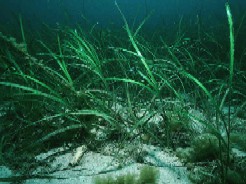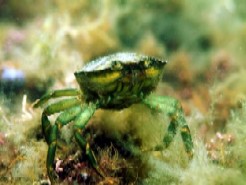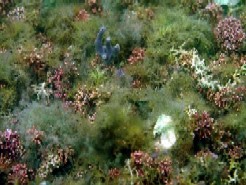Shallow bays and inlets are indentations of the coastline that have no freshwater input or only a low level, i.e., small streams and/or local rainfall runoff. They experience coastal salinities (+30S) continuously. Average water depth is c. 30 metres with at least half of the inlet/bay shallower than 30 metres. Their linear lengths exceed 2km and the length to width ratio is generally greater than 2:1. The levels of exposure to wave action vary from sheltered through semi-exposed to exposed. This is reflected in the sediment type with mud or sandy mud occurring in the sheltered sites to mixed sediments on semi-exposed sites to coarser sediments in exposed sites. The inner parts of some large inlets may be estuarine where the innermost area is strongly influenced by freshwater and are considered as the Annex I habitat Estuary, but the rest of the area is not. The variation in sediment types is reflected in the organic carbon content and numbers of species with maximum biological diversity in softer sediments and lowest diversity occurring in coarse material. Large shallow inlets and bays are a physiographic unit that hosts a great variety of habitats including, the Annex I habitats of the Directive, reefs and mudflats and sandflats not covered by seawater at all times. The sediment habitats and their communities within large shallow inlets are very varied reflecting the broad sediment types. Large shallow inlets and bays are located on all parts of the coastline. The two largest sites are located in the mid-west (Shannon Estuary) and south-west (Dingle Bay).
 |
 |
| Zostera Bed (Photo: MERC) | Green Crab (Photo: MERC) |
Typical species will vary depending on the depth, substrate and degree of exposure to wave action but in general will include the following: Coelenterates: Virgularia mirabilis, Cerianthus llodyii, Sargartiogeton spp., Polycheates: Arenicolaspp., Nephtys hombergii, Hediste diversicolor, Magelona mirabilis, Spio spp., Scoloplos armiger, Lanice conchilega. Crustacea: Pagurus bernhardus, Liocarcinus deputator, Cancer pagurus, Nephrops norvegicus. Bivalves Clausinella fasciata, Pecten maximus, Dosinia exoleta, Lutraria lutraria. Echinoderms: Echinocardium cordatum. Asterias rubens,Astropecten irregularis, Amphiura filliformis, Amphiura brachiata, Amphiura chiajei, Ophiura albida. Fish: Callionymus lyra,Pomatoschistus minutus. Algae: Phymatolithum calcareum, Lithothamnion corallioides. Angiosperms: Zostera spp.
|
Maerl Bed (Photo: MERC) |
For more information click on the following links:
|

